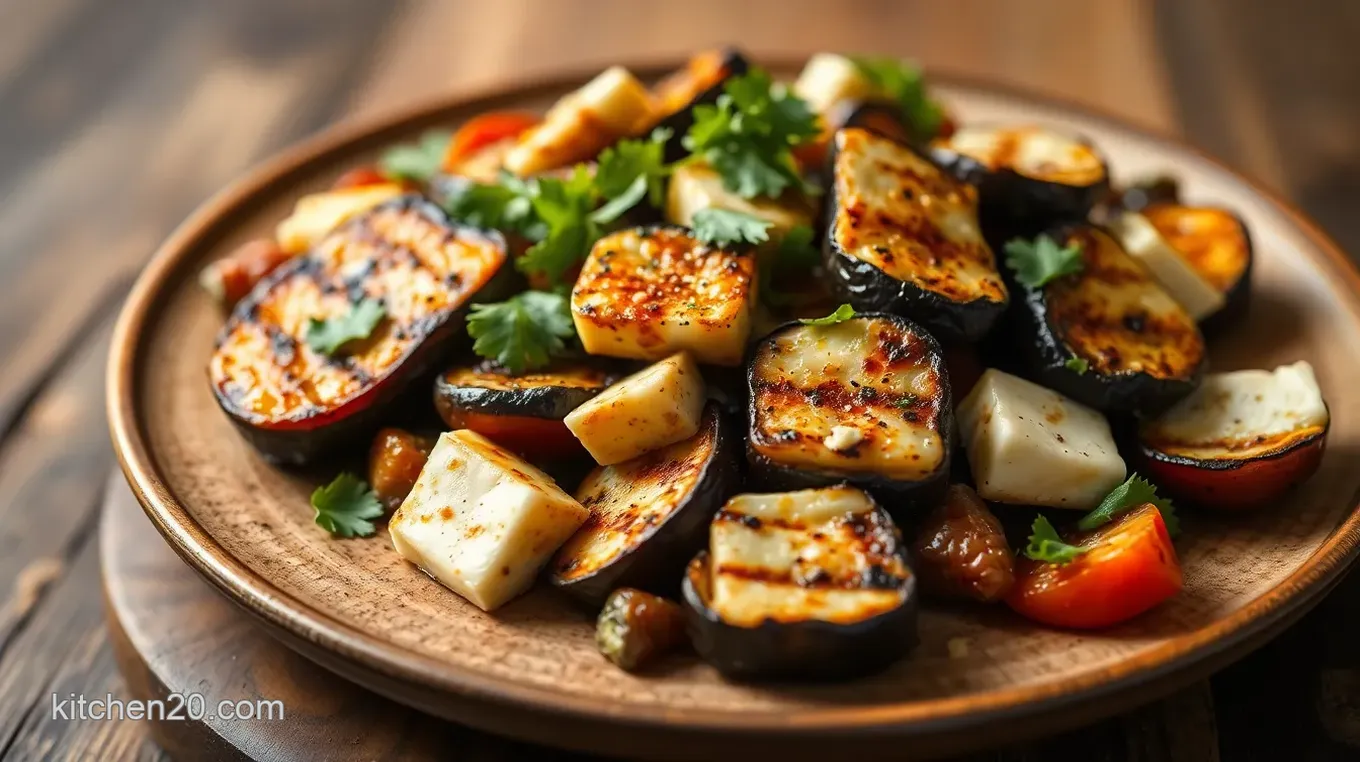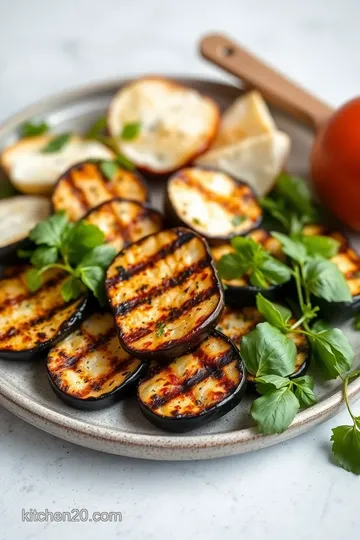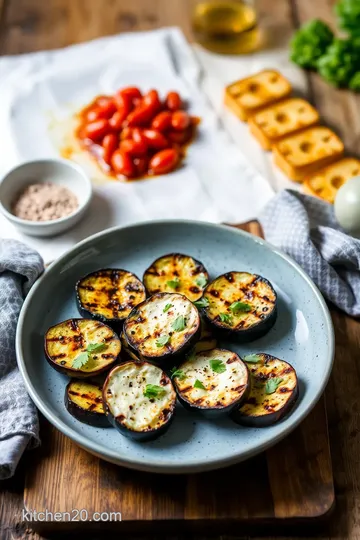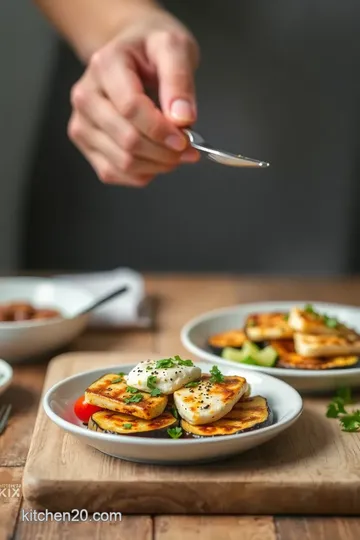Griddled Aubergine Halloumi Salad Delight
Looking for a refreshing salad? Try my Griddled Aubergine Halloumi Salad Delight! With a zesty lemon dressing, it’s a favorite for warm evenings. Enjoy!

The Magic of Griddled Aubergine Halloumi Salad Delight
Honestly, let me tell you about the first time i had something that blew my mind. picture this: i was at a summer bbq with friends, and someone brought a dish called griddled aubergine halloumi salad delight.
Oh my gosh, the smoky aubergine, the kinda crispy yet creamy halloumi, and a dressing that just made everything pop! i was hooked.
It made my taste buds do a little happy dance. since then, i’ve whipped up this vibrant dish whenever i want to impress guests or just treat myself on a summer evening.
Quick Taste of History
So, where does this flavor explosion come from? the combination of grilled eggplant salad and halloumi cheese has its roots in mediterranean cuisine, famous for its bold flavors and fresh ingredients.
The eggplant, or aubergine as the fancy folks might call it, has been a staple in dishes across greece to italy for ages.
And halloumi? it's a delicious cheese from cyprus that grills like a dream! but in today’s world, this recipe has taken off! you’ll find it at hip brunch spots or as part of healthy salad recipes on countless websites.
Making this salad? super easy! you’ll spend about 15 minutes prepping and an additional 10- 15 minutes grilling .
Total time? a breezy 30 minutes! perfect for a quick meal after a long day. and don’t worry about your wallet; this dish is budget-friendly—with basic ingredients yielding servings for four .
Why You’ll Love This Salad
Now, let’s get to some juicy details. Why should this easy vegetable salad be on your radar?
Health benefits galore : first off, eggplants are packed with nutrients. they’re low in calories but high in fiber and antioxidants.
So, you're munching on something that not only tastes great but also packs a punch in the health department! halloumi adds a nice dose of protein, making this a nourishing meal .
Unique selling points : let’s be real, if you're looking for vegetarian picnic food or even something special for a gathering, this dish is a winner.
It’s not just colorful, but also has delightful textures! you’ve got the creamy halloumi and soft, grilled eggplant complementing the zesty lemon dressing.
Occasions to serve : looking for a dish for a summer party? maybe a light lunch or even a dinner to impress your crush? this is it! it's versatile.
Plus, it’s made to be enjoyed fresh, making it a fantastic refreshing summer appetizer .
What really stands out for me is how simple the cooking techniques are. if you’ve got a grill pan or an outdoor grill, you're golden! we’re talking about quick and easy recipes that result in stunning, flavorful plates.
Ready to look into In?
Okay, are you buzzing with excitement yet? let's move on to the ingredients you’ll need to whip up this stunning griddled aubergine halloumi salad delight .
Trust me, you won't regret adding this dish to your cooking repertoire. it's not just a salad; it's a vibrant, colorful celebration on a plate!
Grab your apron, and let’s get to it!

Essential Ingredients Guide
When whipping up something delicious—like that griddled aubergine halloumi salad delight —you want to get each component right. each ingredient brings heaps of flavor and texture, but knowing how to choose and care for them can make or break your dish.
So, let’s break it down!
Premium Core Components
Alright, let’s start with the core ingredients . you’re gonna need 2 medium aubergines (eggplants) , sliced into ½ inch rounds.
If you’re banging this out metric-style, that's about 400g . when picking eggplants, look for ones that feel firm and have smooth skin—those cozy purple guys should slightly spring back when pressed.
Now, halloumi cheese is your next hero. you need about 225g , sliced thick. quality wise? grab the one that smells a bit tangy.
It should also have a nice bounce. the fresher, the better! when it comes to storage, keep it in a container in the fridge, and it'll be good for about a week—but i usually recommend using it sooner rather than later for that tasty goodness!
How about that zesty lemon dressing ? you’ll need tons of flavor for that. so when you’re juicing your lemon, choose one that feels heavy for its size.
You’ll get more juice! store any leftover cuts covered in the fridge.
Signature Seasoning Blend
Now let’s jazz things up with a signature seasoning blend . you’ll need olive oil, salt, and black pepper as your base.
But don’t stop there! fresh herbs like parsley and mint in this recipe? oh my gosh, they just tie everything together! it's all about those herb selections and pairings .
When you chop ‘em up, don’t stress; just make it rough. the more rustic, the better it blends with the grilled flavors.
And if you're feeling adventurous, you can even add a sprinkle of red pepper flakes for a little kick!
Smart Substitutions
If you find yourself in a pinch, don’t worry, we’ve got smart substitutions covered. don’t have halloumi? feta cheese works , too! for a spicy twist, try slicing jalapeños on the side.
Whether you’re vegan or vegetarian, there are always options ready to swoop in and save the day. believe me, you can make a tasty plant-based salad option that rivals the original!
Kitchen Equipment Essentials
So, what tools do you need for this masterpiece? a grill pan or outdoor grill is a must! you’ll also want a mixing bowl for that dressing, some tongs to flip things, and a cutting board with a sharp knife to get those veggie pieces just right.
Though a fancy grill is cool, if you don’t have one, an oven broiler can do the trick! so don’t let lack of equipment hold you back.
Oh, and those leftovers? store them in an air-tight container. they’ll be good for 3-4 days in the fridge. perfect for packing on busy days.
Wrap-Up
Now that you’ve got the scoop on the essentials, you're ready to tackle that griddled aubergine halloumi salad delight . with all these tips on hand, you'll not only nail this salad but also create a stunning dish that dazzles like a summer sunset.
So take a breath, gather your ingredients, and let’s head into those juicy, flavorful step-by-step instructions . your friends are gonna ask for the recipe, trust me!
Mastering the Art of Cooking: Professional Techniques for Home Chefs
When it comes to whipping up a delicious meal, it’s not just about having a great recipe. knowing some professional cooking methods can make a world of difference.
Today, i'm bringing you my take on the essentials you need to elevate your cooking game. let’s jump right into it!
Essential Preparation Steps
Mise en place —you might have heard this french term before. it basically means "everything in its place." before you make your griddled aubergine halloumi salad delight , gather all your ingredients and equipment.
Slice those aubergines (or eggplants) into ½ inch rounds , and get your halloumi ready to grill. organizing everything will save you time and keep the kitchen chaos to a minimum.
Honestly, there’s nothing more frustrating than searching for the olive oil mid-cooking!
Speaking of time, let's talk time management tips . while your eggplant is sweating out some water (don’t skip that step!), whisk the dressing.
You get twice as much done in half the time—who doesn’t love that?
Safety considerations are super important. Always remember to keep a kitchen towel near when grilling. You don’t want to accidentally drop that sizzling hot halloumi on your foot!
Step-by-Step Process
Alright, let's get into the nitty-gritty. Here are some clear, numbered instructions:
-
Prep the Aubergine : Slice it, sprinkle with salt, and let it sit for 10 minutes to draw out moisture.
-
Whisk the Dressing : Mix 3 tablespoons olive oil , the juice of 1 lemon, and a minced clove of garlic. It'll be your zesty superstar!
-
Heat Things Up : Preheat your grill pan to medium-high heat .
-
Grill : Brush that aubergine lightly with olive oil and grill for 4- 5 minutes on each side until it gets those lovely char marks.
-
While that's happening, grill your halloumi cheese slices for 1- 2 minutes on each side till they’re golden and crispy.
Temperature control is crucial here! Make sure your grill is at the right temp for that perfect char.
Expert Techniques
Now, let’s talk about some pro tips to take your cooking to the next level. remember, critical steps are all about the little things that add up to a beautiful dish.
After grilling, look for a nice golden color on your cheese—that's your quality checkpoint .
If things aren’t going as planned, don't panic! Here’s a troubleshooting tip : if your aubergine seems tough, it likely needs a few more minutes on the grill.
Success Strategies
Who hasn't made mistakes in the kitchen? Common mishaps include leaving the salt out or burning those halloumi slabs. Trust me; I’ve been there!
To ensure perfect results every time, always taste as you go . With a dish as versatile as this Mediterranean salad , feel free to adjust the seasoning.
You can also prep some components in advance. for example, you can grill the aubergines a day before and just assemble when it’s time to eat.
Make-ahead options are a lifesaver, especially for light summer meals !
Wrapping It Up with a Bow
So there you have it, a breakdown of professional cooking methods that can transform your culinary adventures. next time you want to impress at the grill, grab those ingredients and make my griddled aubergine halloumi salad delight .
Trust me, it’s a game-changer!
As we continue exploring, i’ll surely be sharing more mediterranean salad ideas and tips for delicious, healthy salad recipes that make eating veggies fun again.
Get ready for more flavorful salad ideas in our next section: additional information!

look into into the Delights of Griddled Aubergine Halloumi Salad Delight
Oh my gosh, have you tried griddled aubergine halloumi salad delight yet? if not, you're really missing out! this salad features smoky griddled eggplant and luscious halloumi cheese .
Paired with a zesty lemon dressing, it’s like a flavor party in your mouth. seriously, it’s the kind of dish that whispers “you’ve made it to summer,” no matter how hot or sticky it is outside.
Let’s dig into some pro tips and secrets that transform this fresh herb-infused dish into a notable. first off, when grilling the eggplant, always sprinkle a bit of salt and let it sit.
Trust me, it draws out the moisture and leaves you with the perfect texture. you won’t be disappointed! want to save time? grill a batch of eggplant and halloumi ahead of time, then toss them into whatever meal you have throughout the week.
I love keeping mine in the fridge just for quick munchies or an easy summer dish.
Perfect Presentation: Making It Insta-Worthy
Now listen up, presentation is key if you want your dish to pop! layer that griddled aubergine halloumi salad in a shallow bowl—think like a rainbow of greens, reds, and yellows.
Cherry tomatoes add sweetness, while fresh parsley and mint bring a touch of color. even a little sprinkle of feta on top can elevate your creation to instagram royalty.
And don't forget to drizzle over that zesty lemon dressing like a pro! your friends will be snapping pics before they even dig into this mediterranean marvel.
Storage & Make-Ahead: Keep It Fresh
If you’re anything like me, meal prep is your best buddy. after dining on fresh, vibrant salads, you might be wondering how to store leftovers.
Keep the salad and dressing separate—this is a lifesaver! you don’t want your salad to get all soggy, right? just pop the extra salad into a container, cover it, and it’ll stay fresh for around 2-3 days.
The dressing? uh, that’ll last about a week. when it's time to eat again, give it a quick toss, and if needed, freshen it up with a tad more olive oil or a splash of lemon.
Creative Variations: Switch It Up
Want to get creative? try adapting the flavors to mix things up. you could swap the eggplant for zucchini if you’re in the mood for something a bit lighter.
Summer grilling often calls for experimenting, and they say variety is the spice of life! if you or a pal follow a specific diet, no worries—you can easily toss in tasty vegan substitutes or even throw in a handful of nuts for a crunchy kick.
Feeling adventurous? how about a sprinkle of smoked paprika for that smoky flavor or some diced avocado for creaminess? the variations are endless.
Grilled vegetable dishes like this one are all about making it yours!
Complete Nutrition Guide: Empower Your Meals
If you’re keen on staying healthy (who isn’t, right?), this salad packs a punch. a single serving can give you around 20g of protein and a good dose of fiber.
Not to mention, eggplant is full of antioxidants and vitamins. eating colorful salads is not just a trend; it’s a lifestyle! so grab those veggies and stack your plates high because good nutrition never tasted so good!
Expert FAQ Solutions: Your Kitchen Companion
Now, let’s tackle some common questions. first off, if you’re wondering why your halloumi isn’t grilling well, check that your grill is hot enough! a good sear is what seals in the flavor.
Also, if your salad turns out too salty, mix in more veggies to balance it out. for those trying to impress, trust me—presentation matters.
Arrange it beautifully, and they will come.
Wrap-Up: Time to Get Cookin'!
So there you have it—some pro tips, exciting variations, and quick storage solutions to whip up your own griddled aubergine halloumi salad delight .
Don't let it be just another recipe; let it be a way to celebrate the warmth of summer and good company.
Go ahead, gather your pals, fire up the grill, and enjoy! you know you want to!

Griddled Aubergine Halloumi Salad Delight Card

⚖️ Ingredients:
- 2 medium aubergines (eggplants), sliced into ½ inch rounds (about 400g)
- 8 ounces (225g) halloumi cheese, sliced into ½ inch thick pieces
- 2 tablespoons olive oil (30ml)
- 1 teaspoon salt (5g)
- ½ teaspoon black pepper (2g)
- 1 cup cherry tomatoes, halved (150g)
- ½ cup fresh parsley, roughly chopped (15g)
- ¼ cup fresh mint leaves, roughly chopped (10g)
- 3 tablespoons olive oil (45ml)
- Juice of 1 lemon
- 1 teaspoon honey or maple syrup (5g)
- 1 clove garlic, minced
- Salt and pepper to taste
🥄 Instructions:
- Step 1: Slice aubergines into ½ inch rounds and sprinkle with salt. Let sit for 10 minutes to draw out moisture. Rinse and pat dry with a paper towel.
- Step 2: In a mixing bowl, whisk together olive oil, lemon juice, honey, garlic, salt, and pepper. Set aside.
- Step 3: Preheat the grill pan or grill over medium-high heat. Brush both sides of the aubergine slices with olive oil and grill for 4-5 minutes on each side until tender and charred.
- Step 4: In the same pan, grill the halloumi cheese slices for 1-2 minutes on each side until golden and crispy.
- Step 5: In a large mixing bowl, combine grilled aubergine, halloumi, cherry tomatoes, parsley, and mint. Drizzle with the lemon dressing and toss gently to combine.
- Step 6: Arrange on a platter or individual plates. Enjoy warm or at room temperature.
Previous Recipe: Quick Broccoli Pasta with Lemon & Chilli: An Easy Family Favorite
Next Recipe: How to Make Delicious Sautéed Turkey Fajitas with Fresh Veggies
